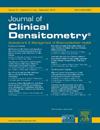Bone Mineral Density and Associated Factors in Individuals with Traumatic Unilateral Transfemoral Amputation
IF 1.6
4区 医学
Q4 ENDOCRINOLOGY & METABOLISM
引用次数: 0
Abstract
Introduction/background: Lower extremity amputations, particularly at more proximal levels such as transfemoral amputations (TFA)s, negatively affect bone mineral density (BMD). The aim of this study was to determine the relationship between muscle strength, residual limb length (RLL), and BMD on the amputated side in individuals with traumatic unilateral TFA and to investigate other potentially related factors.
Methodology: This is a retrospective, cross-sectional study. The study included 39 individuals with TFA. Demographic and clinical data of the individuals were recorded. RLL was determined by measuring the distance from the trochanter major to the most distal end point of the stump. Hip flexor and extensor muscle strengths were assessed by determining peak torque at an angular velocity of 60°/s using an isokinetic system. Dual-energy X-ray absorptiometry (DXA) imaging T-scores of the femoral neck and lumbar spine on the amputee side were evaluated.
Results: There was a statistically significant relationship between peak hip flexion torque and RLL with the femoral neck BMD T-score (r = 0.327*, p = 0.045; r = 0.432*, p = 0.006, respectively). RLL and peak hip flexion torque were identified as determinants of femoral neck BMD T-score (p = 0.004, p = 0.031, respectively). It was found that for every 1 cm increase in RLL, the femoral neck BMD T-score increased by approximately 0.09. A one-unit increase in peak hip flexion torque was associated with an approximate increase of 0.04 in the ipsilateral femoral neck BMD T-score.
Conclusions: In the rehabilitation program of individuals with unilateral TFA, it may be important to plan hip flexor muscle strengthening interventions that may affect BMD. Performing amputation surgeries while preserving RLL at the longest possible length may be beneficial in terms of BMD results on the amputated side.
外伤性单侧经股截肢患者的骨密度及其相关因素
介绍/背景:下肢截肢,特别是近端截肢,如经股截肢(TFA),对骨密度(BMD)有负面影响。本研究的目的是确定外伤性单侧TFA患者截肢侧肌肉力量、残肢长度(RLL)和骨密度之间的关系,并探讨其他潜在的相关因素。方法:这是一项回顾性的横断面研究。该研究包括39名TFA患者。记录患者的人口学和临床资料。RLL是通过测量从大转子到残端最远端点的距离来确定的。通过等速系统测定60°/s角速度下的峰值扭矩来评估髋屈肌和伸肌力量。评估截肢侧股骨颈和腰椎双能x线吸收仪(DXA)成像t评分。结果:髋峰值屈曲力矩、RLL与股骨颈BMD t -评分有统计学意义(r = 0.327*,p = 0.045;R = 0.432*,p = 0.006)。RLL和髋峰值屈曲力矩被确定为股骨颈BMD t评分的决定因素(p = 0.004,p = 0.031)。研究发现,RLL每增加1 cm,股骨颈BMD t评分增加约0.09。峰值髋关节屈曲扭矩每增加一个单位,同侧股骨颈BMD t评分约增加0.04。结论:在单侧TFA患者的康复计划中,制定可能影响BMD的髋屈肌强化干预措施可能很重要。在进行截肢手术的同时尽可能长地保留RLL,对于截肢侧的骨密度结果可能是有益的。
本文章由计算机程序翻译,如有差异,请以英文原文为准。
求助全文
约1分钟内获得全文
求助全文
来源期刊

Journal of Clinical Densitometry
医学-内分泌学与代谢
CiteScore
4.90
自引率
8.00%
发文量
92
审稿时长
90 days
期刊介绍:
The Journal is committed to serving ISCD''s mission - the education of heterogenous physician specialties and technologists who are involved in the clinical assessment of skeletal health. The focus of JCD is bone mass measurement, including epidemiology of bone mass, how drugs and diseases alter bone mass, new techniques and quality assurance in bone mass imaging technologies, and bone mass health/economics.
Combining high quality research and review articles with sound, practice-oriented advice, JCD meets the diverse diagnostic and management needs of radiologists, endocrinologists, nephrologists, rheumatologists, gynecologists, family physicians, internists, and technologists whose patients require diagnostic clinical densitometry for therapeutic management.
 求助内容:
求助内容: 应助结果提醒方式:
应助结果提醒方式:


